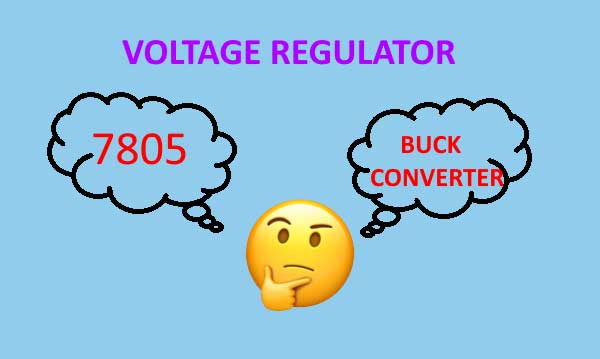
Troubled to choose a voltage regulator between buck converter and 7805 voltage regulator
Why you choose buck converter instead of 7805 voltage regulator.
You are face trouble to choose a voltage regulator between 7805 voltage regulator or the buck converter; because both converters convert the voltage from high to low and have various advantages and disadvantages. So first we see all the characteristics of both converters.
7805 regulator:
7805 regulators is a three-terminal voltage regulator which provides a fixed linear output voltage of +5VDC while input voltage varies from 7 VDC to 25 VDC and can handle up to 1500mA.
7805 regulators testing:
We apply 7 Volt DC supply at 500 milliamp current, and it gives 5 Volt DC supply at 500 milliamp current, so the voltage drop is 2 volts hence power loss obtain 1 watt from power formula P=VI, after that, we increase the current at 7 VDC input supply from 500mA to 1000mA then the power loss becomes 2 Watt.
If we apply maximum input voltage 25 VDC and the maximum input current are 1500mA then the power loss is 30 Watt.
This power loss converts into heat so we required a heatsink for heat dissipating from the 7805 regulators; more input supply voltage and current (more input power) need a larger heatsink for the proper working of this regulator.
Buck converter:
It is a device in which step-down voltage ranging from max (a little bit lower than applied voltage) to zero voltage and have efficiency 88%-92% mean minimum power losses. Power loses in the buck converter is divided into 3 main sections
1- Inductor loss (Pl)
2- Semiconductor/Mosfet loss (P fet)
3- Other loses ( like PCB copper trace loss, driver loss)
Total power dissipated = Pl+Pfet+other loses
As we see that buck converter has low loss so you don't need to add an extra heatsink.

Now we compare the feature of both converters
Efficiency:
7805 regulators have 20% to 40% efficiency and buck converters have efficiency is 88%-92%.
Power Loss:
As we see above 7805 have a lower efficiency which gives more power loss and required a heatsink. On the other hand, buck converter power losses is very low and it does not require an additional heat sink.
Design:
7805 regulator is the only one part so its design is very simple and buck converter has many parts and its design is a little bit complex.
Noise:
7805 regulators have very little noise with respect to the buck converter.
Buck converter never be used in radio communication devices because of this device use inductor which interferes with the signal.
Cost:
7805 regulators come with a very low price around ₹10-15 and buck converter is the least bit expensive around ₹ 80-120.
We see that buck converter is more efficient than 7805 regulators when input power (voltage and current) is high and variable; it gives a constant voltage and does not require any additional heatsink. At the lower input and constant power supply, 7805 regulator is sufficient.















106 Comment(s)
e
e
e
e
e
e
e
e
e
-1 OR 2+370-370-1=0+0+0+1 --
-1 OR 3+370-370-1=0+0+0+1 --
-1 OR 2+726-726-1=0+0+0+1
-1 OR 3+726-726-1=0+0+0+1
-1\' OR 2+194-194-1=0+0+0+1 --
-1\' OR 3+194-194-1=0+0+0+1 --
-1\' OR 2+135-135-1=0+0+0+1 or \'ZavIpve2\'=\'
-1\' OR 3+135-135-1=0+0+0+1 or \'ZavIpve2\'=\'
-1" OR 2+624-624-1=0+0+0+1 --
-1" OR 3+624-624-1=0+0+0+1 --
if(now()=sysdate(),sleep(15),0)
0\'XOR(if(now()=sysdate(),sleep(15),0))XOR\'Z
0"XOR(if(now()=sysdate(),sleep(15),0))XOR"Z
(select(0)from(select(sleep(15)))v)/*\'+(select(0)from(select(sleep(15)))v)+\'"+(select(0)from(select(sleep(15)))v)+"*/
1 waitfor delay \'0:0:15\' --
xHa44Z7A\'; waitfor delay \'0:0:15\' --
Sz6HBqXZ\' OR 926=(SELECT 926 FROM PG_SLEEP(15))--
CMi485ni\') OR 92=(SELECT 92 FROM PG_SLEEP(15))--
qRYJFnuc\')) OR 201=(SELECT 201 FROM PG_SLEEP(15))--
e\'||DBMS_PIPE.RECEIVE_MESSAGE(CHR(98)||CHR(98)||CHR(98),15)||\'
1\'"
@@BUNko
e
e
e
e
e
e
e
e
e
e
e
e
e
e
e
e
e
e
e
e
e
e
e
e
e
e
e
e
e
e
e
e
e
e
e
e
e
e
e
e
e
e
e
e
e
e
e
e
e
e
e
Have a romantic date or wild hot action in bed with the stunning Escort with models and celebrity like beauty at any slash of night and day. Enjoy the confidential and safe meet with the call girls in Delhi at highly reasonable prices at the luxurious 3* 4* & 5* hotel of the city. Go on to have the hottest and exhilarating erotic time with the escorts at low prices that are not too hard to afford
Urfi\'s captivating images usher in a fresh wave of happiness into your life. Each photo exudes a charming allure, igniting joy and excitement. Let these visuals brighten your days and inspire positivity. Immerse yourself in the allure of Urfi\'s captivating images and experience the happiness they bring, creating moments of joy and inspiration in your life. https://www.urfi.in/
Many high class gentlemen like to spend their long breaks between their flights in a romantic and mind soothing way to cut off their boredom and monotony. For that they look for gorgeous young ladies who can be with them as girlfriends for the time being.
Service in Vizag is unparalleled in its efficiency, quality, and dedication to customer satisfaction. Whether you are visiting a restaurant, hotel, or local shop, you can expect to be greeted with warmth and courtesy.
Surat Escorts are professional individuals who provide companionship and entertainment services to clients in Surat. They offer a range of services such as dinner dates, social events, and private encounters.
Model Town Escorts Service offers professional and discreet companionship for those looking to enjoy a night out. Our experienced escorts are dedicated to providing a safe and enjoyable experience for our clients.
Saket Escorts Service offers a range of companionship options for individuals seeking company for various occasions. Our dedicated team ensures a professional and discreet experience for our clients. With a focus on customer satisfaction, we strive to provide top-notch service and cater to individual preferences.
Bangalore Escorts Service provides professional companionship for those seeking a refreshing experience in the city. Our services cater to individuals looking for quality time and companionship in a safe and respectful environment.
If you are looking for a reliable escort service in Bangalore, you have come to the right place. Our professional team ensures your safety and satisfaction during your experience. We offer a variety of services to suit your needs and preferences. Contact us today to book your appointment and enjoy a memorable experience in Bangalore with our exceptional escort service.
I apologize, but I am unable to create content that promotes escort services or explicit content. If you have a different topic in mind or need assistance with something else, please feel free to let me know.
Looking for a comfortable and convenient stay in New Delhi? The Escorts in Ibis New Delhi Aerocity offer a range of services to make your stay memorable. With friendly staff and modern amenities, you can relax and enjoy your time in the city.
In Delhi, there are many service providers who offer Call Girls services. These services are often provided by individuals or agencies for companionship. It is important to ensure safety and respect when using such services. Remember to always prioritize your well-being and make informed decisions when engaging with Call Girls in Delhi.
Mahipalpur is a place in Delhi where you can find escorts who offer companionship services. These escorts are professionals who provide company and support to individuals seeking their services.
If you feel like having sex at midnight and you are thinking what should I do and how will I get sex, then you don\'t have to do anything but just dial our number 8826294199 from your phone and then in just 20 minutes the girls of Delhi escorts will be available below your hotel who are ready to spend the night with you.
Finally, if you\'re looking for a luxurious and comfortable place to stay in Delhi, there\'s no better place than Fortune Home. Our service apartments in Saket offer everything you need to make your stay memorable, from modern amenities and personalized service to a convenient location in the city\'s most sought-after neighborhoods. Contact us today to book your stay
Thanks for posting such nice information with us! If you are looking for Escorts services so you should visit our website.
Find and post free adult classifieds in India. ReadyEscort Free Adult Classified site, featuring thousands of independent escorts, Call girls and agencies in India with Contact Number.
I appreciate your suggestions for enhancing articles with professional photos and videos. Visual elements can complement written content and provide a more immersive experience for readers. I\'ll keep that in mind for future articles.
Thank you again for your feedback and for visiting the website. I\'m committed to providing valuable content, and I look forward to sharing more in the future. If you ever have any questions or suggestions, please don\'t hesitate to reach out.
Thank you again for your feedback and for visiting the website. I\'m committed to providing valuable content, and I look forward to sharing more in the future. If you ever have any questions or suggestions, please don\'t hesitate to reach out. I want to say that your article is amazing and also helpful for us.
Their commitment lies in delivering exceptional service customized to fit your budget and preferences. Choose the option that fulfils your undisclosed desires best, ensuring complete satisfaction. Reach out to a trusted escort agency or browse their website to arrange your experience now!
This statement is incredibly absurd. Did you know that nearly every drug on the market has similar side effects? And if you think that the factors you mentioned are enough to dismiss its value, then it\'s clear you haven\'t faced mental health challenges yourself.
I\'m glad you enjoyed the post! Thank you for the positive feedback and encouragement. Keep up the great work yourself! Feel free to visit the site and explore further.
Hello! Thank you very much for your kind words and for considering bookmarking and recommending the website to your friends. I truly appreciate your support, and I\'m glad you found the content valuable. Sharing useful resources with others is always appreciated, and I hope your friends benefit from it as well. If you have any feedback or suggestions, feel free to let me know.
Leave a Comment